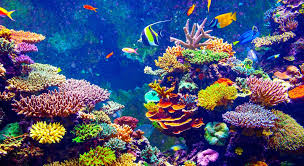來源于《商業(yè)》版塊
Coral reefs
珊瑚礁
No longer in the pink
不再健康
The world is going to have to start thinking radically to save its coral reefs
世界將不得不開始從根本上思考如何拯救珊瑚礁
Corals are comeback creatures. As the world froze and melted and sea levels rose and fell over 30,000 years, Australia’s Great Barrier Reef, which is roughly the size of Italy, died and revived five times. But now, thanks to human activity, corals face the most complex concoction of conditions they have yet had to deal with. Even these hardy invertebrates may struggle to come through their latest challenge without a bit of help.
珊瑚是回歸的生物。隨著世界冰凍、融化,海平面在3萬多年間起起落落,澳大利亞的大堡礁,這個和意大利差不多大的地方,經(jīng)歷了五次死亡和復活。但現(xiàn)在,由于人類的活動,珊瑚面臨著迄今為止最復雜的混合環(huán)境。即使是這些頑強的無脊椎動物,在沒有一點幫助的情況下,可能也很難度過最近的挑戰(zhàn)。
According to the Intergovernmental Panel on Climate Change, a rise in global temperatures of 1.5°C relative to pre-industrial times could cause coral reefs to decline by 70-90%. The planet is about 1°C hotter than in the 19th century and its seas are becoming warmer, stormier and more acidic. This is already affecting relations between corals and the single-celled algae with which they live symbiotically, and which give them their colour. When waters become unusually warm, corals eject the algae, leaving reefs a ghostly white. This “bleaching” is happening five times as often as it did in the 1970s. The most recent such event, between 2014 and 2017, affected about three-quarters of the world’s reefs. Meanwhile the changing chemistry of the oceans lowers the abundance of carbonate ions, making it harder for corals to form their skeletons.
根據(jù)政府間氣候變化專門委員會的數(shù)據(jù),全球氣溫與工業(yè)化前相比上升1.5攝氏度,可能會導致珊瑚礁面積減少70-90%。地球的溫度比19世紀高了1攝氏度,海洋也變得越來越溫暖,風暴也越來越多,酸性也越來越強。這已經(jīng)影響到珊瑚與它們共生的單細胞藻類之間的關(guān)系,而單細胞藻類賦予了珊瑚顏色。當海水變得異常溫暖時,珊瑚會排出藻類,使珊瑚礁呈現(xiàn)出幽靈般的白色。這種“漂白”現(xiàn)象發(fā)生的頻率是上世紀70年代的5倍。最近一次這樣的事件發(fā)生在2014年至2017年之間,影響了全球約四分之三的珊瑚礁。同時,海洋化學物質(zhì)的變化降低了碳酸鹽離子的豐度,使得珊瑚更難形成骨骼。

If corals go, divers and marine biologists are not the only people who will miss them. Reefs take up a fraction of a percent of the sea floor, but support a quarter of the planet’s fish biodiversity. The fish that reefs shelter are especially valuable to their poorest human neighbours, many of whom depend on them as a source of protein. Roughly an eighth of the world’s population lives within 100km of a reef. Corals also protect 150,000km of shoreline in more than 100 countries and territories from the ocean’s buffeting, as well as generating billions of dollars in tourism revenue. In the Coral Triangle, an area of water stretching across South-East Asia and into the Pacific which is home to three-quarters of known coral species, more than 130m people rely on reefs for food and for their livelihoods in fishing and tourism.
如果珊瑚消失了,潛水者和海洋生物學家不是唯一會想念它們的人。珊瑚礁只占海床的百分之一,卻支撐著地球上四分之一的魚類生物多樣性。珊瑚礁中棲息的魚類對它們最貧窮的人類鄰居來說尤其有價值,他們中的許多人依賴它們作為蛋白質(zhì)的來源。世界上大約有八分之一的人口生活在距珊瑚礁100公里以內(nèi)的地方。珊瑚還保護著100多個國家和地區(qū)15萬公里的海岸線免受海洋沖擊,并為旅游業(yè)帶來數(shù)十億美元的收入。珊瑚三角區(qū)是一片水域,橫跨東南亞,一直延伸到太平洋,是四分之三已知珊瑚物種的家園。在這里,超過1.3億人依靠珊瑚礁獲取食物,靠捕魚和旅游業(yè)維持生計。
譯文由可可原創(chuàng),僅供學習交流使用,未經(jīng)許可請勿轉(zhuǎn)載。












